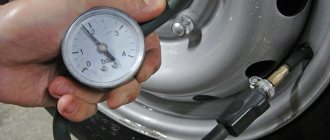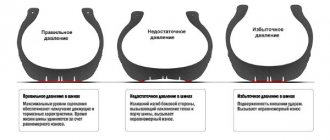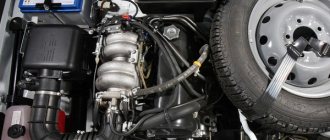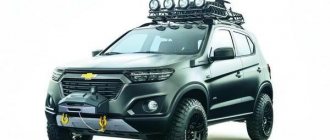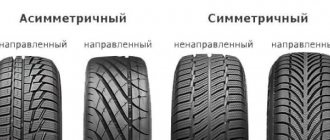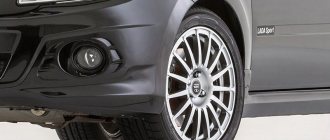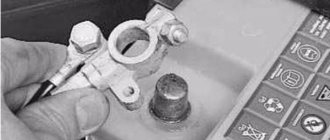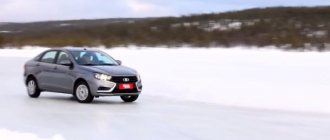The right tires ensure wheel grip on the road, help the car respond correctly to steering wheel turns, and also minimize braking distances during emergency braking. Therefore, most owners pay close attention to the tire model, rubber compound and other factors (including even driving style) when choosing a suitable set of shoes.
But even with original tires, a car can be more controllable, comfortable and responsive than one shod with expensive models. The reason is a negligent attitude to the pressure inside the tires. This parameter is very important and largely depends on the ambient temperature. If this indicator is far from optimal, this can lead to dangerous or unpleasant situations.
For example, increased pressure inside the wheels is fraught with:
— the possibility of damage to the cord and damage to the tire;
- accelerated tread wear;
- deterioration in ride comfort and ride comfort;
If the owner has poorly inflated the tires, then the disadvantages include:
— increased effort when turning the steering wheel;
— deteriorated acoustic comfort inside the cabin;
— rapid overheating of tires and, as a result, accelerated wear of the entire tread or any part of it;
— potential damage to the cord;
- slow response to steering wheel turns;
— increased rolling resistance and increased car appetite.
There is an option with different tire pressures. If such wheels are installed on the same axle, then:
- car controllability decreases;
— he doesn’t hold his trajectory well, trying to move aside on his own;
- this is especially felt during intense acceleration - you have to make great efforts to hold the steering wheel.
Why measure tire pressure on Niva Chevrolet
Before you start measuring tire pressure, you need to decide on the units of pressure measurement. The most common are bar and atmosphere (atm.). Many people consider them identical, but this is not entirely true. If we take one normal atmosphere (760 mm Hg) as 1, then 1 bar will be 1.0133 atm. The difference of less than 2% is caused by the peculiarity of the mmHg conversion. Art. to Pascals in the SI system. All modern pressure gauges are marked in bars or atmospheres.
Timely monitoring of tire pressure affects:
- stability of straight motion;
- maximum braking distance of a car;
- stability and safety of control in extreme conditions;
- uniform tire tread wear;
- eliminates damage to tire sidewalls and cords;
- reduces fuel consumption at all speeds.
The pressure in Niva Chevrolet tires may be too low or too high . The behavior of the car on the road differs from this value as follows.
Important! The nominal level for wheels with landing radius R15, R16 is taken to be the factory setting of 1.9 bar.
Blood pressure is higher than normal . The car's ride becomes harsher, the contact patch with the road surface decreases, and directional stability deteriorates. The braking distance increases greatly, especially on wet or slippery surfaces. Characteristic bald spots appear on the tread in the middle of the wheel. An overinflated wheel is much easier to damage, and strong impacts are transmitted to the disc and suspension elements.
Underinflated wheels increase the effort on the steering wheel of the car and significantly increase gas mileage. The behavior of the SUV on hard surfaces becomes slack, the car yaws and floats on the road at high speed. The tread wears out from the edges of the tire, and the sidewall becomes cracked. Such a wheel cannot protect the disc from a strong impact when falling into a hole.
Advice. If the pressure on all wheels is not uniform, the car will pull towards the flat tire.
The causes of flat tires are universal for all brands of cars - punctures, damage to the beads, curvature of the wheel rim, air leakage through the valve, drying out and loss of tightness of tires due to age.
Recommended tire and wheel sizes for Lada 4×4
The size of the tires and wheels greatly influences the behavior of the car on the road. AvtoVAZ recommends installing tires and wheels of a strictly defined size on Lada 4×4; only in this case the manufacturer guarantees the service life of chassis and suspension components and assemblies. In the review, we will tell you what the size of the wheels affects during the operation of the machine and what recommendations the manufacturer gives.
Instruments and methods for measuring pressure
Chevy Niva tire pressure measurements are carried out with any mechanical or electronic pressure gauge:
- Mechanical dial pressure gauges are considered simple and unpretentious devices. The operating principle is based on a cylinder with a piston and a spring, and an arrow associated with it. Measuring range from 0.1 bar to 8 bar. The disadvantage of pointer instruments is the low measurement accuracy and dependence on the ambient temperature (underestimates readings in winter). Pros: reliable and cheap, do not require a power source.
- Electronic or digital pressure gauges . Modern high-precision instruments. Models from well-known manufacturers have minimal errors. Equally accurate in winter and summer. Cons: high price, less reliability.
Important! Measurements are made with a stationary vehicle and cold tires. After driving, you should let the car sit for 2-3 hours in summer or up to half an hour in winter. The correct order of measurements is indicated in the instructions for the pressure gauge.
The disk-tire system is not completely sealed, especially on off-road vehicles , which include the Chevrolet Niva. Air under pressure will always find a place to escape, so such pressure checks should become regular, and not 1-2 times a year when changing tires. The optimal mode is to check once every 2-3 weeks, before a long trip and after off-road trips.
Advice. Many drivers forget about the condition of the spare tire and only remember it when changing it. A deflated spare wheel will not help if a tire punctures, and you will only be able to drive a deflated wheel for a few kilometers, after which the tire will most likely have to be thrown away.
Recommendations
Comments 28
My father has winter tires on a Shevik of this size and the same summer tires for now. It pumps 2.1 - 2.2 atm, since he drives a lot over bumps and potholes, of which there are a lot on the way from the village where he lives to the city. On a short Niva on summer wheels (MT 215/75 R15 tires) I pump 1.7 - 1.9 atm, it’s softer, but it’s almost impossible to break through this tire on bumps from the start, even on half-flat tires. Winter tires 215/65 R16 (tire profile height is approximately the same as 205/70 R16) - I get 2.0 points. If I had a Shniva, I would pump 2.1 - 2.2 like my father.
I have the same winter studded one on my Chevy Niva. I download 2-2.1 no more. Otherwise it’s very tough and the cross-country ability drops. I've driven it 35t and it's like new. True, I lost a few spikes on the front end, I planted the car badly, there was ice and snow on top, rubble under the ice. So I got out of my head.
Try it in different ways, but I don’t recommend less than 2, it depends on the chassis; it depends on the chassis; a friend has stuck the gas no matter how you pump it; it’s still rigid, but it holds the rolls; I don’t need it; I often drive on the ground; there’s shaking; the tin everything rattles.
I always pump 2.5-3, normally, softly.
What's the point of pumping 2.5-3 into such tires? Low profile 2.5 is pumped, 225/40 P17 for example.
I don’t know, I’m just used to pumping 2.2 in P13, 2.5 in P14, 3 in P15 in the summer (2.5 in winter). One of the advantages for me is good rolling and consumption, and the likelihood of hitting the disc is less. Idk, I'm used to it already.
Try pumping up 2.0 in the P15 205/70, it definitely shouldn’t be worse. But in winter, why 2.5? The tires get dull in the winter anyway, but there’s still a pressure of 2.5...
1.8-1.9 is what it says in the smart book about our car, and the tire brand has nothing to do with it
I download KUMHO KW21 at 2.3-2.4 and in the summer Bridstone Ecopia 150 at 2.2 in a circle, it was from the Barguzin factory at 2, it downloaded more like riding a cart
I use the same sneakers 2.2, even on Volgograd roads it’s quite smooth. I also download Muda 2.2 in the city.
Why pressure in such tires for a low profile?
What does the profile have to do with it in general?) The weight of the car plays a role and what kind of road it is. In gazelles, the profile is higher and you need to pump according to book 3, despite the fact that the gazelle tires are heavier by half a ton.
The profile matters; the smaller the profile, the greater the pressure. We're talking about passenger cars, let's not talk about gazelles, etc. On 205 and 70 profiles there is no need to pump more than 2.0, it will only be harder and the rubber will die faster.
Why will this kill the rubber? The rubber is killed when 4 are pumped and the middle swells like a house. I drove gazelles for 7 years and I know exactly under what conditions the tires wobble faster from experience. Everyone on mudas from 29′ pumps at least 2 atm, I don’t think that they are all stupid.
I can’t say anything about gazelles. But as for the muds, I’ll say that I’m not sure that everyone is downloading 2 atm, I’ve read a lot on this topic, there is an opinion that it’s worth downloading 1.8. But at 205/70 p15 it’s exactly 2.5-3 atm. It's not worth downloading. 4 drifters say that the car skidded better and the tires smoked...
I'm on Pirelia 215 RUR 16 2.2 download
Why 2.2. in 215 tires, where is the logic?
Well, that means a person likes it) I’m comfortable with the 2.2, there’s less tire wear, better dynamics and handling. Although in comparison with 1.9 the difference cannot be felt by the body, this is only a theory.
Less tire wear? This is a mistake; when pumping, the rubber wears out much faster.
Yes, what a pumping))) read the literature at your leisure)
I read that 2.2 is certainly not terrible, but you definitely don’t need to pump it at 205/70.
Why 2.2. in 215 tires, where is the logic?
Soft and rolls better
The roll-up will be better, I agree, but as for the soft one, it’s unlikely...
I download matadlras at 2.3 (they are very soft), and in the summer I downloaded yoku at 1.9. I think Nordmaster should not be pumped to less than 2 atmospheres)
Off-road wheels on Chevy Niva
The difference between special off-road tires and all-season tires lies in a different power structure and standard size. Among the manufacturers of mud tires for Chevrolet Niva, BFGoodrich, Cordiant, Forvard, Federal Mogul and others have proven themselves well. They produce tires in sizes 215/65/R15, 215/75/R15, 225/65/R15, which fit on the Niva with minimal modifications to the standard wheel arches. Tread type M/T or A/T.
Off-road tires are distinguished by increased lugs and a reinforced tire sidewall . In addition, it is elastic and works well when deflated to a minimum. The working pressure of mud tires directly depends on the type of terrain being overcome. On rocky soils it is recommended to pump up to 2.3-2.5 atmospheres. This increases the ground clearance and traction properties of the tires. On muddy ground, sand or snow, the pressure is released to 0.8-1 bar. The tires roll well and allow you to overcome very difficult areas.
About winter tires on Lada 4×4
When choosing tires for the winter, use the table above. In addition, it is allowed to use winter tires (M+S) of the above dimensions and index Q with a corresponding limitation of the maximum vehicle speed (up to 160 km/h).
Choose winter tires on your Lada 4×4 that are as narrow as possible so that the pressure of the car on the surface is greater, this will improve traction. Also remember that wide tires are more sensitive to the ruts on the road.
Niva Chevrolet and low pressure wheels
Low-pressure tires or arched tires are highly specialized tires that are designed primarily for constant use in severe off-road conditions, in swampy areas, and deep snow. They differ from ordinary off-road wheels in their width, light weight, and the normal pressure in such wheels is 0.5-0.7 bar.
It is impossible to install low-pressure tires on a standard Chevrolet Niva without modifying the car . You will need to lift the car and suspension, change the main pairs, strengthen the suspension elements, and install a pumping system. Such tuning turns the Niva into an excellent rogue on any terrain.
Disadvantages of low pressure tires in everyday use:
- short wheel life;
- reduction of maximum speed;
- deterioration in controllability;
- decreased reliability of the vehicle transmission;
- transfer of the car to the section of self-propelled vehicles;
- increased gasoline consumption.
Chevrolet Niva tires
Service station experts recommend installing tires on a Chevrolet Niva strictly according to the season, thereby eliminating universal, all-season tires. When operating a machine in high positive or negative temperatures, the rubber composition changes its properties, thereby deteriorating the technical characteristics.
Before purchasing tires for a Chevrolet Niva yourself, get advice from specialists regarding the compatibility of tires with your car model.
ATTENTION! A completely simple way to reduce fuel consumption has been found! Don't believe me? An auto mechanic with 15 years of experience also didn’t believe it until he tried it. And now he saves 35,000 rubles a year on gasoline! Read more"
Consequences of incorrect tire pressure
Most car owners should remember the manufacturer's recommended tire pressure value for Chevrolet Niva - 1.9 bar . This is a normal value that should be used as a starting point when making adjustments up or down. Minor deviations will not lead to adverse consequences. There may be an increase in fuel consumption or slight discomfort in the car interior.
But deviations from the norm of 0.5 atmospheres or more already have a serious impact on safety and controllability and cause increased tire wear. To avoid this, it is recommended to always have a high-quality pressure gauge in your car and regularly measure the pressure in all wheels, including the spare tire.
Features of pumping in winter
Since in winter the tire’s grip patch should be slightly larger than in summer, you should slightly reduce the pressure in the wheels of your Niva 2121 or 21214. This is due to the fact that the road surface is most often covered with ice. The larger the adhesion area, the lower the risk of an accident. Under the weight of the car, the tire “sags”, the tread opens up more, which ensures tight traction of the wheel even with bare ice and at high speed.
Standard tire pressure for Niva 2121 and 21214
Consequence of violation of regulatory pressure Niva 21213
If you do not adhere to the described operating requirements, the following will happen:
- Increased load on chassis parts will lead to premature wear and failure.
- Fuel consumption will increase due to the fact that the flat tire has a larger contact area. The protector, having opened, prevents movement. The engine will need to develop more power.
- The tires will wear out quickly. The reason for this is the increased contact patch with the road surface. By the way, lateral abrasion indicates that the tire is flat, and it is necessary to urgently take measurements and eliminate the cause.
- The risk of getting into an accident increases significantly, especially if you overinflate your tires in winter.
But if you monitor the amount of air in the slopes, the Chevrolet Niva will always remain a safe car with outstanding cross-country characteristics.
Source 5net.ru
International NIVA Club
|
Forums
| Photo gallery | NIVA-SHOP | Files | Video |
- List of forumsAuto - EquipmentTechnical section Lada 4x4 NivaOff-road
- Search
- Links
- Unanswered topics
- Active topics
- Search
Table of standards for various tires
| Tire type | Front, atm | Rear, atm |
| 205/70 R15 | 2.1 | 2.1 |
| 205/75 R15 | 2.1 | 2.1 |
| 215/65 R16 | 2.2 | 2.2 |
Attention! The pressure in the rear tires should be approximately 0.3 - 0.5 bar higher if you plan to carry a heavy load.
In winter, you can slightly reduce the amount of air to increase the tire contact area with the road.
So, dear car enthusiasts, do not forget to regularly check the tire pressure, because the safety of you and your loved ones depends on it.
